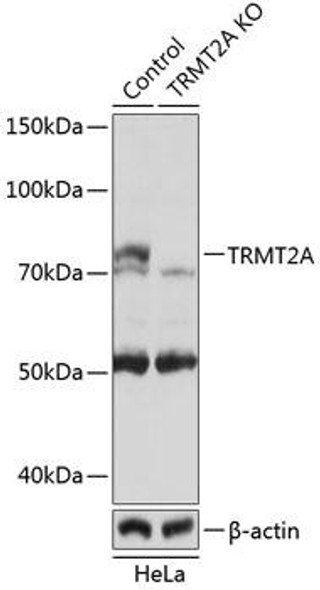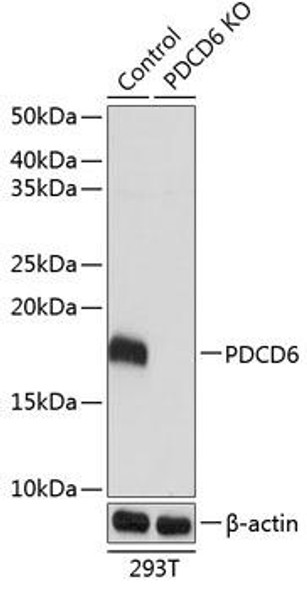Description
Anti-KMT2A Antibody[KO Validated] (CAB1435)
The KO Validated KMT2A Rabbit Polyclonal Antibody is a high-quality research tool specifically designed for studies involving KMT2A, a key protein associated with gene regulation and development. This antibody, produced in rabbits, has been rigorously validated for knockout (KO) experiments and is highly reactive with human samples.KMT2A, also known as MLL, plays a crucial role in epigenetic regulation and is frequently implicated in leukemia and other cancers. Understanding its function and regulation is essential for unravelling the complexities of gene expression and disease development. The KO Validated KMT2A Rabbit Polyclonal Antibody allows for precise detection and analysis of KMT2A protein expression in various cell types, making it an invaluable tool for researchers in the fields of molecular biology and cancer research.
With its sensitivity and specificity, this antibody is ideal for use in techniques such as Western blotting, immunohistochemistry, and immunoprecipitation. By targeting KMT2A, researchers can gain deeper insights into its role in normal cellular processes and disease pathology, paving the way for potential therapeutic advancements in cancer treatment and gene therapy.
| Antibody Name: | Anti-KMT2A Antibody[KO Validated] |
| Antibody SKU: | CAB1435 |
| Antibody Size: | 20uL, 50uL, 100uL |
| Application: | WB IHC IF |
| Reactivity: | Human, Mouse, Rat |
| Host Species: | Rabbit |
| Immunogen: | Recombinant fusion protein containing a sequence corresponding to amino acids 752-949 of human KMT2A (NP_005924.2). |
| Application: | WB IHC IF |
| Recommended Dilution: | WB 1:500 - 1:2000 IHC 1:50 - 1:200 IF 1:50 - 1:200 |
| Reactivity: | Human, Mouse, Rat |
| Positive Samples: | 293T |
| Immunogen: | Recombinant fusion protein containing a sequence corresponding to amino acids 752-949 of human KMT2A (NP_005924.2). |
| Purification Method: | Affinity purification |
| Storage Buffer: | Store at -20°C. Avoid freeze / thaw cycles. Buffer: PBS with 0.02% sodium azide, 50% glycerol, pH7.3. |
| Isotype: | IgG |
| Sequence: | SHSM RTRS GRLS SSEL SPLT PPSS VSSS LSIS VSPL ATSA LNPT FTFP SHSL TQSG ESAE KNQR PRKQ TSAP AEPF SSSS PTPL FPWF TPGS QTER GRNK DKAP EELS KDRD ADKS VEKD KSRE RDRE REKE NKRE SRKE KRKK GSEI QSSS ALYP VGRV SKEK VVGE DVAT SSSA KKAT GRKK SSSH DSGT DITS VT |
| Gene ID: | 4297 |
| Uniprot: | Q03164 |
| Cellular Location: | Nucleus |
| Calculated MW: | 427kDa/431kDa/432kDa |
| Observed MW: | 200KDa |
| Synonyms: | KMT2A, ALL-1, CXXC7, HRX, HTRX1, MLL, MLL1, MLL1A, TRX1, WDSTS, MLL-AF9, MLL/GAS7, TET1-MLL |
| Background: | This gene encodes a transcriptional coactivator that plays an essential role in regulating gene expression during early development and hematopoiesis. The encoded protein contains multiple conserved functional domains. One of these domains, the SET domain, is responsible for its histone H3 lysine 4 (H3K4) methyltransferase activity which mediates chromatin modifications associated with epigenetic transcriptional activation. This protein is processed by the enzyme Taspase 1 into two fragments, MLL-C and MLL-N. These fragments reassociate and further assemble into different multiprotein complexes that regulate the transcription of specific target genes, including many of the HOX genes. Multiple chromosomal translocations involving this gene are the cause of certain acute lymphoid leukemias and acute myeloid leukemias. Alternate splicing results in multiple transcript variants. |
| UniProt Protein Function: | MLL: Histone methyltransferase that plays an essential role in early development and hematopoiesis. Catalytic subunit of the MLL1/MLL complex, a multiprotein complex that mediates both methylation of 'Lys-4' of histone H3 (H3K4me) complex and acetylation of 'Lys-16' of histone H4 (H4K16ac). In the MLL1/MLL complex, it specifically mediates H3K4me, a specific tag for epigenetic transcriptional activation. Has weak methyltransferase activity by itself, and requires other component of the MLL1/MLL complex to obtain full methyltransferase activity. Has no activity toward histone H3 phosphorylated on 'Thr-3', less activity toward H3 dimethylated on 'Arg-8' or 'Lys-9', while it has higher activity toward H3 acetylated on 'Lys-9'. Required for transcriptional activation of HOXA9. Promotes PPP1R15A-induced apoptosis. Chromosomal aberrations involving MLL are a cause of acute leukemias. Translocation t(1;11)(q21;q23) with MLLT11/AF1Q; translocation t(3;11)(p21;q23) with NCKIPSD/AF3p21; translocation t(3,11)(q25,q23) with GMPS; translocation t(4;11)(q21;q23) with AFF1/MLLT2/AF4; insertion ins(5;11)(q31;q13q23) with AFF4/AF5Q31; translocation t(5;11)(q12;q23) with AF5-alpha/CENPK; translocation t(6;11)(q27;q23) with MLLT4/AF6; translocation t(9;11)(p22;q23) with MLLT3/AF9; translocation t(10;11)(p11.2;q23) with ABI1; translocation t(10;11)(p12;q23) with MLLT10/AF10; t(11;15)(q23;q14) with CASC5 and ZFYVE19; translocation t(11;17)(q23;q21) with MLLT6/AF17; translocation t(11;19)(q23;p13.3) with ELL; translocation t(11;19)(q23;p13.3) with MLLT1/ENL; translocation t(11;19)(q23;p23) with GAS7; translocation t(X;11)(q13;q23) with FOXO4/AFX1. Translocation t(3;11)(q28;q23) with LPP. Translocation t(10;11)(q22;q23) with TET1. Translocation t(9;11)(q34;q23) with DAB2IP. Translocation t(4;11)(p12;q23) with FRYL. Fusion proteins MLL-MLLT1, MLL-MLLT3 and MLL-ELL interact with PPP1R15A and, on the contrary to unfused MLL, inhibit PPP1R15A-induced apoptosis. A chromosomal aberration involving MLL may be a cause of chronic neutrophilic leukemia. Translocation t(4;11)(q21;q23) with SEPT11. Belongs to the histone-lysine methyltransferase family. TRX/MLL subfamily. 2 isoforms of the human protein are produced by alternative splicing. |
| UniProt Protein Details: | Protein type:Methyltransferase, protein lysine; Transcription factor; Oncoprotein; Cell cycle regulation; EC 2.1.1.43; Methyltransferase Chromosomal Location of Human Ortholog: 11q23 Cellular Component: nucleoplasm; histone methyltransferase complex; cytoplasm; nucleus Molecular Function:identical protein binding; protein binding; protein homodimerization activity; zinc ion binding; AT DNA binding; unmethylated CpG binding; histone lysine N-methyltransferase activity (H3-K4 specific); chromatin binding; transcription factor activity Biological Process: transcription from RNA polymerase II promoter; establishment and/or maintenance of chromatin architecture; embryonic hemopoiesis; apoptosis; positive regulation of transcription, DNA-dependent; histone H3-K4 methylation; positive regulation of transporter activity; positive regulation of histone H3-K4 methylation; anterior/posterior pattern formation; negative regulation of cell proliferation; DNA methylation; protein complex assembly; positive regulation of transcription from RNA polymerase II promoter; circadian regulation of gene expression Disease: Hairy Elbows, Short Stature, Facial Dysmorphism, And Developmental Delay |
| NCBI Summary: | This gene encodes a transcriptional coactivator that plays an essential role in regulating gene expression during early development and hematopoiesis. The encoded protein contains multiple conserved functional domains. One of these domains, the SET domain, is responsible for its histone H3 lysine 4 (H3K4) methyltransferase activity which mediates chromatin modifications associated with epigenetic transcriptional activation. This protein is processed by the enzyme Taspase 1 into two fragments, MLL-C and MLL-N. These fragments reassociate and further assemble into different multiprotein complexes that regulate the transcription of specific target genes, including many of the HOX genes. Multiple chromosomal translocations involving this gene are the cause of certain acute lymphoid leukemias and acute myeloid leukemias. Alternate splicing results in multiple transcript variants.[provided by RefSeq, Oct 2010] |
| UniProt Code: | Q03164 |
| NCBI GenInfo Identifier: | 146345435 |
| NCBI Gene ID: | 4297 |
| NCBI Accession: | Q03164.5 |
| UniProt Related Accession: | Q03164 |
| Molecular Weight: | |
| NCBI Full Name: | Histone-lysine N-methyltransferase 2A |
| NCBI Synonym Full Names: | lysine methyltransferase 2A |
| NCBI Official Symbol: | KMT2A |
| NCBI Official Synonym Symbols: | HRX; MLL; MLL1; TRX1; ALL-1; CXXC7; HTRX1; MLL1A; WDSTS |
| NCBI Protein Information: | histone-lysine N-methyltransferase 2A |
| UniProt Protein Name: | Histone-lysine N-methyltransferase 2A |
| UniProt Synonym Protein Names: | ALL-1; CXXC-type zinc finger protein 7; Myeloid/lymphoid or mixed-lineage leukemia; Myeloid/lymphoid or mixed-lineage leukemia protein 1; Trithorax-like protein; Zinc finger protein HRXCleaved into the following 2 chains:MLL cleavage product N320Alternative name(s):N-terminal cleavage product of 320 kDa; p320 |
| UniProt Gene Name: | KMT2A |
| UniProt Entry Name: | KMT2A_HUMAN |

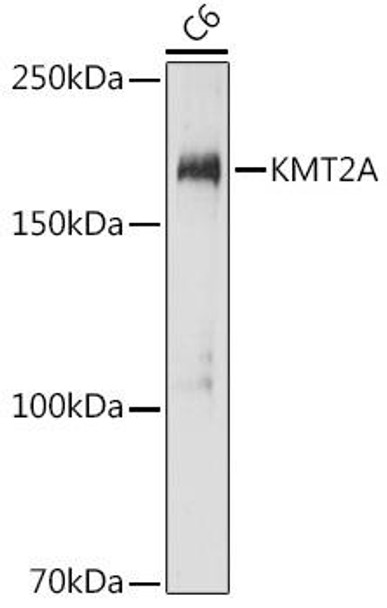
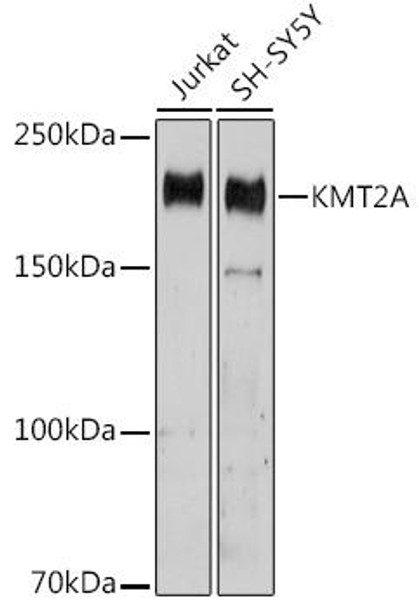
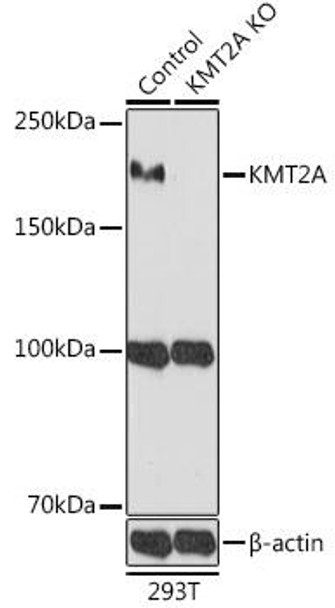

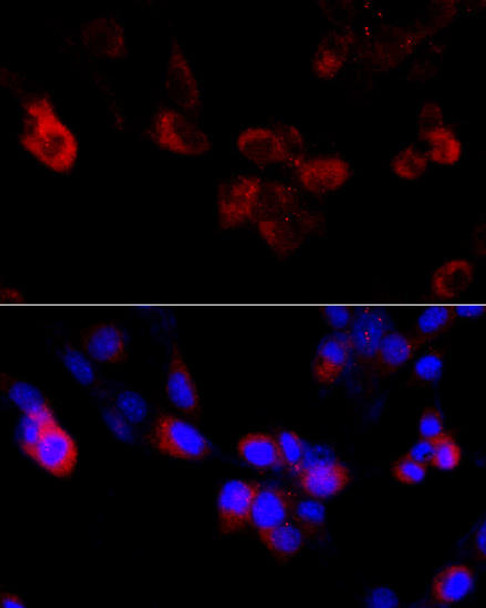





![Anti-KMT2A Antibody[KO Validated]](https://cdn11.bigcommerce.com/s-h68l9z2lnx/product_images/t/627/A1435_1__39167.jpg)
![Anti-KMT2A Antibody[KO Validated]](https://cdn11.bigcommerce.com/s-h68l9z2lnx/product_images/m/130/A1435_2__76920.jpg)
![Anti-KMT2A Antibody[KO Validated]](https://cdn11.bigcommerce.com/s-h68l9z2lnx/product_images/x/063/A1435_3__97151.jpg)
![Anti-KMT2A Antibody[KO Validated]](https://cdn11.bigcommerce.com/s-h68l9z2lnx/product_images/h/694/A1435_4__86713.jpg)
![Anti-KMT2A Antibody[KO Validated]](https://cdn11.bigcommerce.com/s-h68l9z2lnx/product_images/w/617/A1435_5__29332.jpg)


